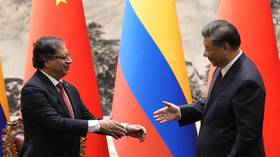How China is wooing a close US partner and why it’s working

Colombian President Gustavo Petro made an official visit to Beijing and met with Chinese leader Xi Jinping on Wednesday. The two countries officially upgraded their relationship to a ‘strategic partnership’, elevating their economic and diplomatic cooperation.
China has established over 100 ‘strategic partnerships’ in the world since the end of the Cold War. This umbrella term is usually an expression of commitment to a long-term, stable, and mutually beneficial partnership, and signifies that the two countries have a number of common goals and interests, and a desire to work on them together – usually trade- and investment-related.
A strategic partnership with China is not an alliance. Some of them can be with countries that have been aligned with the US and have even shown brazen hostility towards China in recent years, such as Australia. Beijing ultimately sees the establishment of these partnerships as critical to ensuring its own place in the world, thwarting long-term US attempts to isolate it, and creating pathways to its own development.
The establishment of a strategic partnership with Colombia is an interesting development. South America, or Latin America as a whole, is a relatively new frontier for China’s diplomatic engagement in the 21st century. Until recently, China focused extensively on expanding its ties with the West, and the US had effectively made most of the Western hemisphere into its diplomatic backyard, imposing anti-communist regimes and deliberately interfering in the form of coups and wars, which ultimately made it difficult for other external players to break through.
Colombia is one such country that has been dominated by the US, even to the point of becoming one of its closest partners in the Americas. As one of the region’s key oil-producing countries, the US has made a lot of effort to keep Colombia under its sphere of influence to control and exploit its resources, creating a regime whereby a small US-leaning elite class are enriched by this arrangement, while most of the country remains in poverty. Thus, Colombia has relied extensively on US support in order to maintain the status quo against revolutionary insurgencies, while at the same time fighting the ever-growing influence of drug cartels.
However, the wind of change has been sweeping Colombia as well as other countries in Latin America. In the past few years, a wave of leftist election victories on the continent was triggered by growing economic disillusionment, aggravated by the Covid-19 pandemic. Colombia witnessed often violent demonstrations which sought the removal of the US-leaning, right wing, democratic center party. The accumulative result of these protests brought to power the left-leaning president, Gustavo Petro, a former communist guerilla himself. Naturally, this comes with a reassessment of Colombia’s foreign policy alignment regarding the US.
Even before the change of government, Colombia increasingly found China to be an essential economic partner. For Latin American countries, their diplomatic arrangements with the US are usually a one-way affair in Washington’s favor. Beijing, on the other hand, has offered tangible infrastructure development, such as building Bogota an entire subway system. As an oil and petroleum importer, China is constantly looking for new sources of energy and has devoted significant diplomatic capital to building ties with countries that offer this, including the Gulf States of the Middle East, Iran, Russia, Ecuador, and now, of course, Colombia.
As the West pursues ‘decoupling’ or, as some in the EU would put it, ‘de-risking’ from China, Beijing is also looking for new export markets to continue its economic growth. Latin America, home to over 600 million people, offers a lot of opportunity, and China, in turn, is open for Latin American products other than oil – such as coffee, which China’s enormous population has been consuming more and more.
Strategic partnerships such as the one with Colombia are vital to keeping Beijing’s trade ticking by opening new markets and insulating China from US efforts to completely isolate it through sanctions and trade wars. China’s strategy is no longer to rely on the West for development, but to forge new development partnerships with Global South countries, in turn giving them the opportunity to propel their growth through access to China.
This changes the global order as it undermines the traditional economic dominance which had enabled the US to become a gatekeeper to Latin American development. Having been left poor and disillusioned by Washington’s heavy-handed approach, countries in the region are now turning to China as an alternative, re-writing the map after almost two centuries of the Monroe Doctrine.
The statements, views and opinions expressed in this column are solely those of the author and do not necessarily represent those of RT.














